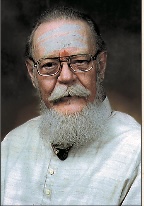By Devananda Tandavan
Here are three important milestones which we reach in our lifetimes–childhood, from birth to age 16 (kapha), adulthood from 16 to 50 (pitta) and old age from 50 onwards (vata). These three cycles co-exist with the cycle of the body’s constitution, and at the juncture of each period a great turmoil naturally occurs.
During the first transition, called puberty, the body and mind are growing, maturing and adjusting to a new purpose in life; i.e., procreation. Puberty brings with it a collision between kapha and pitta which, in itself, is trying and explosive.
Parents should teach their daughters what to expect when puberty begins. On average it starts at about age ten but may occur as early as eight. The first signs are budding of the breasts and growing of pubic and underarm hair. Coarse hair on the legs and arms may also appear. The body experiences a surge of growth that begins at the feet and leads to an awkward gait. This is followed by a lengthening of the legs which may produce even more clumsiness.
Often a skin condition called acne develops which brings great concern to the girl because it is unsightly, and she may be the only one in her class to be so marked. This can best be treated, as can all of the indications of puberty, by eating a pitta-satisfying ayurvedic diet, by having plenty of exercise and by seeing that the digestive process is always functioning at an optimum.
While these external metamorphoses are happening, marked changes are going on within the body. The sexual organs begin to grow, as well as an awareness of them. Hormonal changes commence which will initiate menarche, but this beginning of the menstrual cycle comes fairly late in the puberty process. It may initially occur as a feeling of dampness or only as a spot of blood. As she develops further, the flow increases. When the ovaries begin producing eggs, the flow usually becomes more regular. In the meantime, the breasts continue to enlarge, and their ultimate size is determined by genetic and other factors which cannot be predicted.
Along with physical changes come psychological transformations which may lead to erratic behavior, moodiness, inactivity and self-protecting attitudes. These must be understood as a part of the grand process of growing into adulthood. Many children may not desire this change because they have developed a dependency on being a child. On the other hand, most welcome it with excitement and look at it as a time of great challenge.
A blooming young lady may feel a need to experiment with her independence by desiring to do more things for herself and separating at times from authority figures. Usually this is not a troublesome phase if it is understood as a normal part of development. The main emotional problems to be dealt with are self-consciousness, a feeling of isolation and of “being different.”
Teaching celibacy and planning early for the coming-of-age samskara, the ritukala, will help her to adjust to this period of change and prepare for adult responsibilities. A persistent healthy diet, good exercise, meditation, parental guidance and understanding siblings will insure that she grows and matures into a graceful, beautiful, loving, alluring, mystifying and exciting embodiment of Shakti, capable of bearing wonderful children.
Dr. Tandavan, 76,retired nuclear physician and hospital staff president, lives in Chicago, where he specializes in alternative healing arts. Visit his home page at the Hinduism Today Website.
